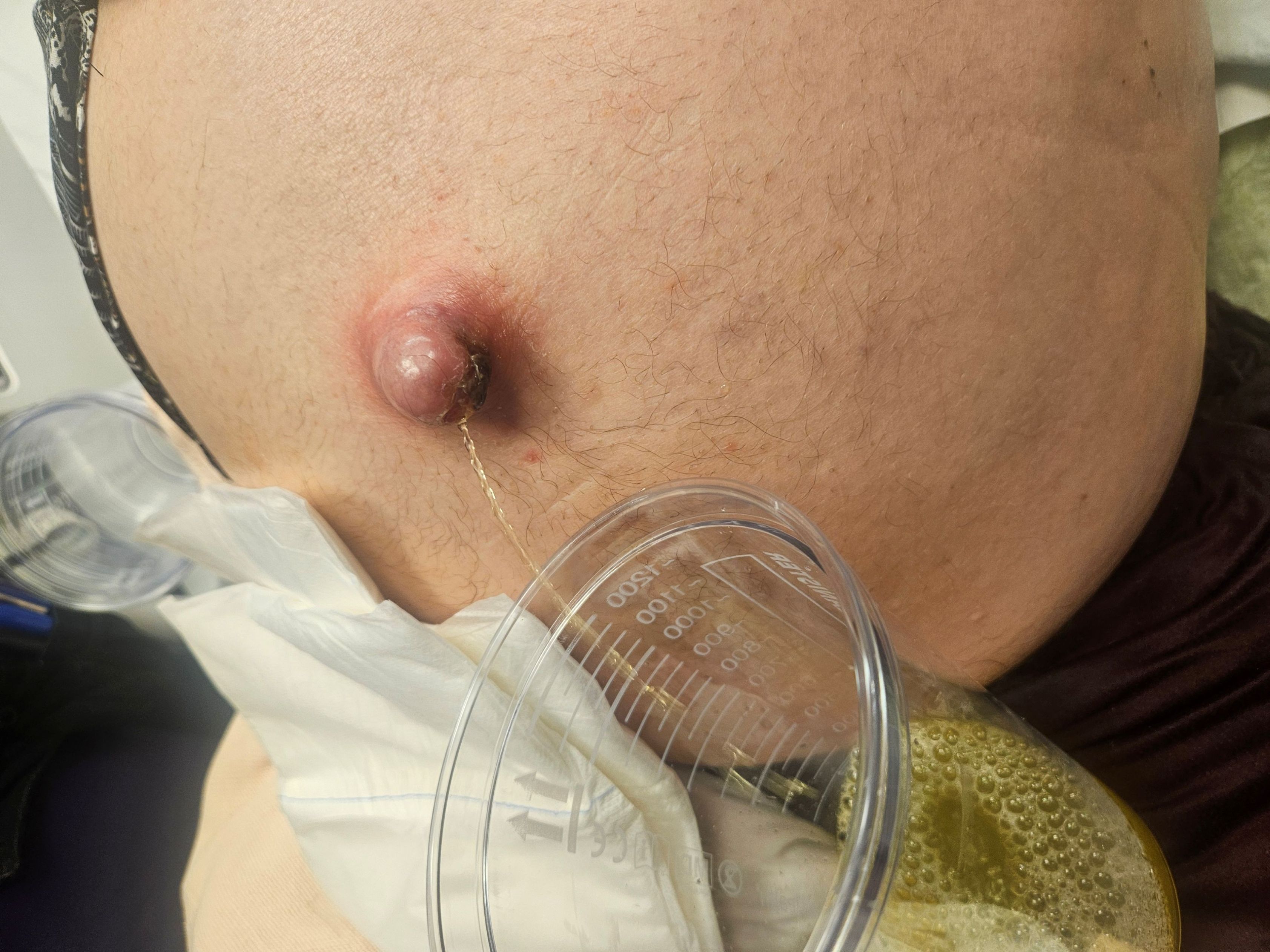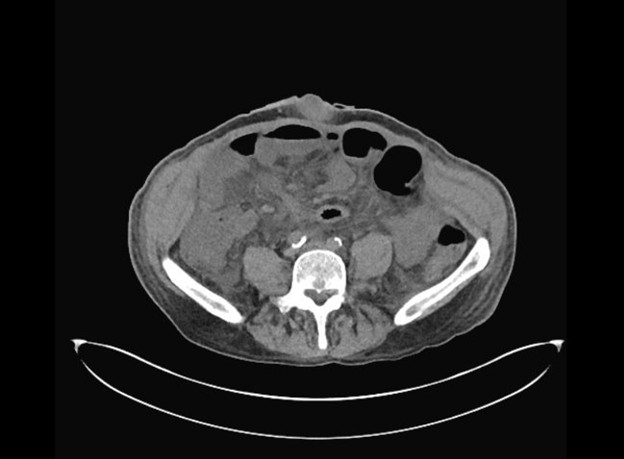Tuesday Poster Session
Category: Liver
P5975 - A Burst of Excitement: Case Presentation of Flood Syndrome
Tuesday, October 28, 2025
10:30 AM - 4:00 PM PDT
Location: Exhibit Hall
- SU
Shana Usiukiewicz, MD (she/her/hers)
College of Medicine, University of Oklahoma Health Sciences Center
Oklahoma City, OK
Presenting Author(s)
Donald Kastens, MD1, Alistair Świerkiosz, BS2, Shana Usiukiewicz, MD3
1University of Oklahoma Health Sciences Center, Oklahoma City, OK; 2University of Oklahoma College of Medicine, Oklahoma City, OK; 3College of Medicine, University of Oklahoma Health Sciences Center, Oklahoma City, OK
Introduction: Flood syndrome is the sudden drainage of ascitic fluid through an umbilical hernia. The term was aptly named by Dr. Frank B. Flood in the 1961 New England Journal of Medicine case series Spontaneous Perforation of the Umbilicus in Laennec's Cirrhosis with Massive Ascites. Patients with large volume ascites are at increased risk of umbilical hernia formation and inadequate ascitic fluid control puts patients at risk for drainage through the umbilical hernia. Patients typically present with cutaneous ulcerations or lesions at the site of the umbilicus prior to drainage. Typically preceded by an increase in intra-abdominal pressure (e.g., emesis, straining, coughing).
Case Description/
Methods: We present the case of a 57-year-old man with recently diagnosed alcohol cirrhosis complicated by recurrent ascites presenting with chief complaint of dyspnea and abdominal distention. Patient had required multiple paracenteses over the preceding months for recurrent ascites in the setting of diuretic non-adherence. Most recently had three liters of ascitic fluid removed approximately two weeks prior to presentation. Patient additionally noted recent viral illness with recurrent coughing. Labs were notable for a mild leukocytosis (WBC 12.8), thrombocytopenia (platelets 128), normal renal function, hyperbilirubinemia (total bilirubin 4.2). MELD 3.0 calculated to be 18 on arrival. Gastroenterology consulted on admission for hyperbilirubinemia and decompensated cirrhosis. On evaluation, found to have spontaneous drainage from umbilicus as pictured. Received albumin infusion and close monitoring in the ICU. In total, 28 liters of ascitic fluid drained over the course of approximately 24 hours. General surgery consulted for umbilical hernia management, however deferred until hepatic disease managed. Interventional radiology consulted for TIPS evaluation; however, patient left against medical advice prior to definitive management. Outpatient hepatology follow-up pending at time of report.
Discussion: Cirrhosis and its many complications are well detailed; however the coexistence of the two common entities of ascites and umbilical hernias leading to Flood syndrome are not well detailed. Many deleterious complications from Flood syndrome exist including bowel incarceration, hypotension, cellulitis, peritonitis, renal failure, and a mortality rate of 30%.Treatment algorithms are lacking and further follow-up of cases, such as the one presented here, can lead to assistance in understanding management of these patients.

Figure: Drainage of ascitic fluid through umbilical hernia

Figure: CT abdomen/pelvis demonstrating umbilical hernia
Disclosures:
Donald Kastens indicated no relevant financial relationships.
Alistair Świerkiosz indicated no relevant financial relationships.
Shana Usiukiewicz indicated no relevant financial relationships.
Donald Kastens, MD1, Alistair Świerkiosz, BS2, Shana Usiukiewicz, MD3. P5975 - A Burst of Excitement: Case Presentation of Flood Syndrome, ACG 2025 Annual Scientific Meeting Abstracts. Phoenix, AZ: American College of Gastroenterology.
1University of Oklahoma Health Sciences Center, Oklahoma City, OK; 2University of Oklahoma College of Medicine, Oklahoma City, OK; 3College of Medicine, University of Oklahoma Health Sciences Center, Oklahoma City, OK
Introduction: Flood syndrome is the sudden drainage of ascitic fluid through an umbilical hernia. The term was aptly named by Dr. Frank B. Flood in the 1961 New England Journal of Medicine case series Spontaneous Perforation of the Umbilicus in Laennec's Cirrhosis with Massive Ascites. Patients with large volume ascites are at increased risk of umbilical hernia formation and inadequate ascitic fluid control puts patients at risk for drainage through the umbilical hernia. Patients typically present with cutaneous ulcerations or lesions at the site of the umbilicus prior to drainage. Typically preceded by an increase in intra-abdominal pressure (e.g., emesis, straining, coughing).
Case Description/
Methods: We present the case of a 57-year-old man with recently diagnosed alcohol cirrhosis complicated by recurrent ascites presenting with chief complaint of dyspnea and abdominal distention. Patient had required multiple paracenteses over the preceding months for recurrent ascites in the setting of diuretic non-adherence. Most recently had three liters of ascitic fluid removed approximately two weeks prior to presentation. Patient additionally noted recent viral illness with recurrent coughing. Labs were notable for a mild leukocytosis (WBC 12.8), thrombocytopenia (platelets 128), normal renal function, hyperbilirubinemia (total bilirubin 4.2). MELD 3.0 calculated to be 18 on arrival. Gastroenterology consulted on admission for hyperbilirubinemia and decompensated cirrhosis. On evaluation, found to have spontaneous drainage from umbilicus as pictured. Received albumin infusion and close monitoring in the ICU. In total, 28 liters of ascitic fluid drained over the course of approximately 24 hours. General surgery consulted for umbilical hernia management, however deferred until hepatic disease managed. Interventional radiology consulted for TIPS evaluation; however, patient left against medical advice prior to definitive management. Outpatient hepatology follow-up pending at time of report.
Discussion: Cirrhosis and its many complications are well detailed; however the coexistence of the two common entities of ascites and umbilical hernias leading to Flood syndrome are not well detailed. Many deleterious complications from Flood syndrome exist including bowel incarceration, hypotension, cellulitis, peritonitis, renal failure, and a mortality rate of 30%.Treatment algorithms are lacking and further follow-up of cases, such as the one presented here, can lead to assistance in understanding management of these patients.

Figure: Drainage of ascitic fluid through umbilical hernia

Figure: CT abdomen/pelvis demonstrating umbilical hernia
Disclosures:
Donald Kastens indicated no relevant financial relationships.
Alistair Świerkiosz indicated no relevant financial relationships.
Shana Usiukiewicz indicated no relevant financial relationships.
Donald Kastens, MD1, Alistair Świerkiosz, BS2, Shana Usiukiewicz, MD3. P5975 - A Burst of Excitement: Case Presentation of Flood Syndrome, ACG 2025 Annual Scientific Meeting Abstracts. Phoenix, AZ: American College of Gastroenterology.
